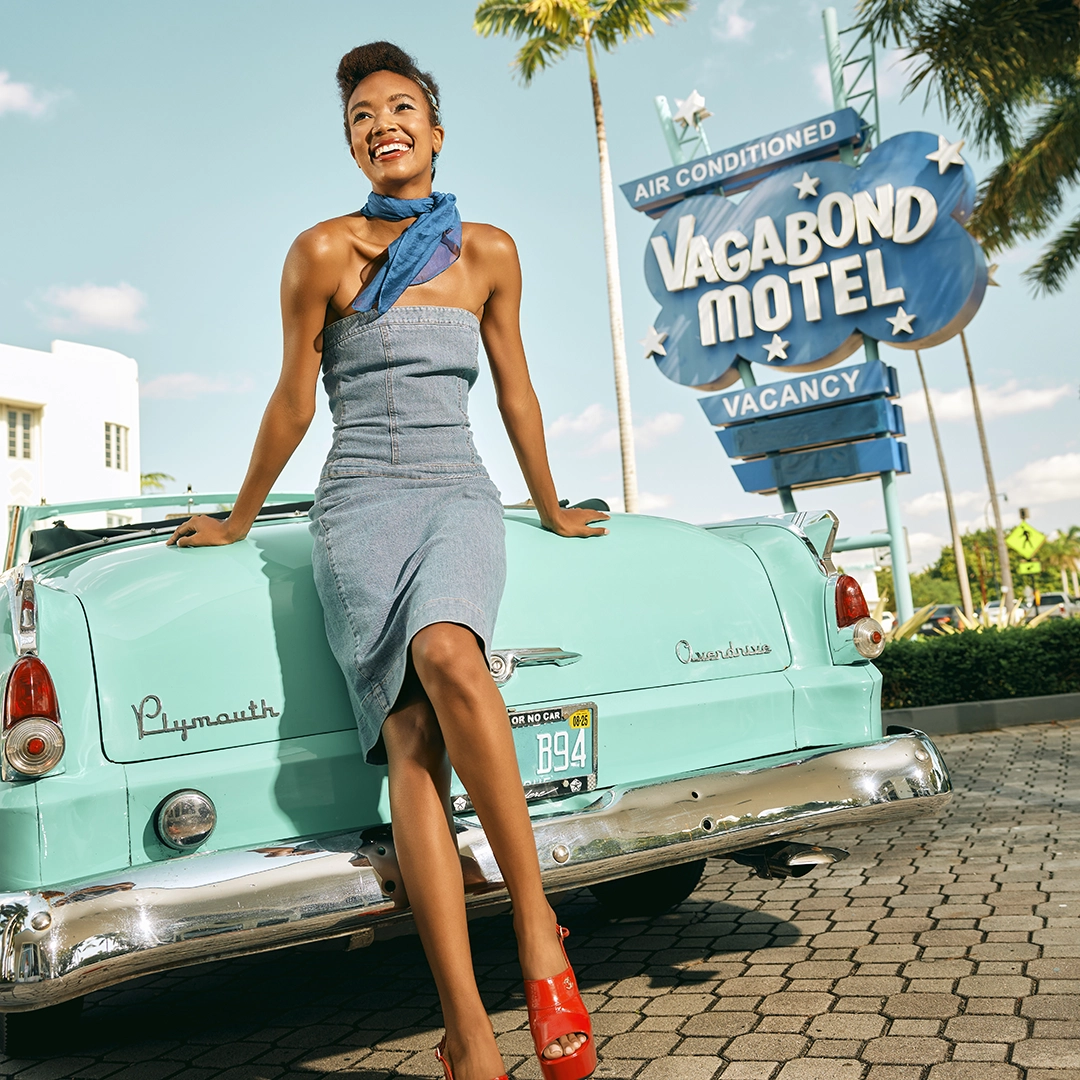by Eric Barton | August 26, 2019
Masterworks In A Selfie World, A Study of Florida Museums
Florida’s museums return to serious places of reflection and inspiration by ditching crowd-pleasing blockbuster shows for critically acclaimed art

Bonnie Clearwater pauses next to a stark white wall near the entrance of Fort Lauderdale’s art museum. The echoing click of her heels on the terrazzo floors served as a backbeat to the tour she has just given me of the institution’s collection, and the sudden silence provides a dramatic effect. It is this piece of art, the museum’s curator explains, that inspires the entire show.
The wall stretches probably 15 feet wide and twice as tall, and it appears to be quite nearly empty. Perhaps she’s about to explain that the piece has been removed for cleaning. You’d be forgiven for thinking Clearwater was joking.
Wearing an ankle-length fish-print dress and a short-cropped haircut that gives her the air of a SoHo artist, Clearwater lifts up her hand and holds it parallel to the floor, as if balancing a teacup. Above her palm is a small placard. Black aluminum with a silver border and matching letters, it looks like a simple nameplate that would hang outside an office. Its message also happens to be the name of the show currently on display: “Remember to React.”
Neo-conceptual artist Jenny Holzer made the piece in 1984. Holzer made a name for herself by printing and projecting messages on New York City buildings. Clearwater says not long after taking the job running the NSU Art Museum Fort Lauderdale in 2013, she discovered the piece in the museum’s permanent collection. The museum possesses some 7,000 works, including the largest collection of the works of American painter William J. Glackens and the nation’s largest collection of COBRA works, products of a European avant-garde movement that sprung up after the Second World War.

Clearwater, 62, had every piece pulled out of storage, photographed and recorded. The process allowed her to consider how the pieces might go together, ways in which she might be able to present them to the public with a clear theme. When Clearwater came to the Holzer piece, the message struck her. In this always-connected era, where we lose ourselves in our phones instead of what’s really in front of us, Clearwater appreciated the reminder to react, to process the thing we’re experiencing. Around that singular piece, she built a show that demonstrated how artists influence each other, how they react to the art of their time.

“There’s no aesthetic to it,” Clearwater explains. “Ultimately, its purpose is to be a sign.”
The purpose of the sign, and of the show altogether, is to ask people to rethink how they define art. Whether you can appreciate it or not, it’s challenging and thought-provoking and, until recently, the kind of show you might have to go out of state to find. Since the early 2000s, many of Florida’s art institutions have chased attendance figures by hosting traveling exhibits that critics often roundly reject as pandering to the masses and offering little cultural value.

A new class of curators and directors at many of the state’s art museums has changed that. They talk now about reshaping their institutions into ones that will gain critical acclaim while still, they hope, attracting the crowds.
It’s often said that, no matter what hangs on its gallery walls, the finest piece of art at Fort Lauderdale’s downtown museum will be the dramatic building designed by architect Edward Larrabee Barnes. Originally founded in a Las Olas storefront in 1958, the museum now boasts a lauded permanent collection and, under Clearwater, seeks an international reputation.
“There’s no reason to program a museum for residents and winter visitors and want them to leave their brains behind,” says Kristen A. Shepherd, executive director of the Museum of Fine Arts, St. Petersburg. “You can have that thought-provoking, engaging show without that cotton candy experience.”
So, how do the state’s museums forge a future without gimmicks? They all say, unequivocally, it’ll be about real, high-quality art.
THE NEW BLOCKBUSTER MASTERPIECE
The Museum of Fine Arts, St. Petersburg is Florida’s only comprehensive art museum, meaning it displays everything from classics to contemporary, covering 5,000 years of human creativity. It’s akin to the Metropolitan Museum of Art in New York, and since Margaret Acheson Stuart founded it in 1965, the MFA has also strived for the Met’s level of excellence in art.

Although, lately, not as much. From November 2018 through April, the MFA filled its galleries with the traveling show Star Wars and the Power of Costume. The show first opened in Times Square in 2015 as a way to help promote a new Star Wars movie, and it has traveled the country since. In the first three months the MFA attendance doubled as people sought out Princess Leia’s gown and Darth Vader’s, well, whatever it is Darth Vader wears. The museum saw a 97 percent increase in visitors from Tampa Bay and a 123 percent jump from visitors from other parts of Florida during the run of the show. Undoubtedly the museum drew crowds, but the show is also an example of the kind of blockbusters that will become far scarcer, if not entirely absent, at Florida museums.

The Star Wars show at the MFA was programmed before the arrival of Shepherd, 48, who was hired in 2016 to take the helm of the museum. Since her arrival, the museum has stopped hosting traveling exhibitions that often aren’t about art and instead has begun programming shows that will aim to provide a scholarly perspective.
But the crowds won’t disappear just because the MFA won’t be displaying blockbusters anymore, Shepherd says. During the recent show of Jean Schlumberger jewelry, “People would literally walk in and gasp” at the beauty of the pieces, she says. People would return to the show to bring friends, and images of the jewelry were frequently posted on social media networks. She expects the same reaction at this fall’s exhibition of work by Jennifer Angus, who transforms rare insects into little pieces of art on their own. The idea is to attract the crowds without a dumbed-down mass-market show, by offering exhibits that provide artistic and educational value.

The huge traveling shows that have filled museums in recent years have not only attracted crowds but also often become points of conversation, pop culture references, for better or worse. Perhaps the best known of the bunch is one that got its start in Florida. Bodies: The Exhibition is a traveling collection of corpses preserved and stripped of their skin to reveal the muscles and organs beneath. It opened at the Museum of Science and Industry in Tampa in 2005. Since then, the show claims, more than 15 million worldwide have seen it. Aside from the question of whether the show offers artistic value, it has notably garnered criticism, along with some outright bans, by states and entire countries because of concerns over the origins of the cadavers.
Margaret Acheson Stuart founded The Museum of Fine Arts, St. Petersburg in 1965 with the goal of creating an intimate and elegant space, and it quickly became a city landmark. The museum hired Kristen A. Shepherd as its head in 2016, three decades after she had visited as a middle-schooler—her first time in an art museum.
It’s also easy to question the financial worth of the shows. Generally these spectacles require museums to turn over every dime of ticket sales, and the shows often take over every gallery, meaning the museums don’t have the chance to display items from their permanent collections. All the museums get in return is the opportunity to sell more yearly memberships and to expose a new crowd to the very idea of visiting a museum—but studies have questioned whether either of those strategies comes to fruition after traveling shows leave town.

Without high-profile exhibits with mass-market appeal, Florida museums need to find new ways to engage with audiences. Across the bay at the Tampa Museum of Art, director Michael Tomor is introducing a new series featuring visiting masterpieces. The idea is a single work so significant that it should be a draw on its own, a one-piece blockbuster. This fall, the Tampa Museum will display a piece by Jean-Michel Basquiat, who went from graffiti artist to neo-expressionist. It gives Tomor and the museum a chance to talk about the black American experience, how found objects can become art and the larger socio-economic and political issues raised by the late artist’s work.

Aside from the potential crowds, Tomor says the idea behind the visiting masterpiece is quite simple: to provide a possible moment of inspiration. When he was a boy in El Paso, Texas, Tomor went on an elementary school field trip to the local art museum. Hanging on the walls were works full of rich colors and shapes that looked nothing like the world he knew before. “El Paso is extremely colorful—but it’s 5,000 shades of brown,” Tomor jokes. The moment he saw those masterpieces, Tomor knew he would work in the art world.

After arriving in Tampa in 2011, Tomor gave an interview to the Tampa Bay Times that might have alarmed serious art aficionados. Tomor said that museums needed to act more like the Golden Corral, providing a lot of art for not a lot of money. “Nobody is selling the Golden Corral as fine dining,” Tomor, 56, says now, when asked about that comment. Likewise, museums, he says, need to balance the art that will be lauded by critics and serious art experts with the kinds of shows that will bring in families and those who might otherwise rarely visit a museum.
“Are we telling our community what they should think of as art, or are we asking our community what they think?” Tomor says. “I think it should be both.”
There’s no doubt far more people will come to the museum next year for the display of Egyptian antiquities than for that single piece. But Tomor imagines the Basquiat might provide a moment like the one he had as a child, where a one-piece show just might inspire someone to discover a new world of art.
A GOAL: REAL ART ON DISPLAY
Adam Levine first set down the path of becoming a museum director after taking a work-study job in college at Dartmouth’s art museum. Over the next three years working in the museum’s public relations and exhibitions departments, Levine saw how museums can make great art accessible. Levine went on to get his doctorate in art history at Oxford. There, he had access to the Ashmolean, the world’s oldest university museum, opened in the 1600s. Levine, 33, says the museum provided “education for the studious and entertainment for the curious”—a goal he says should be adopted by all art museums.

Since January 2019, Levine has served as director and CEO of the Cummer Museum of Art & Gardens in Jacksonville, and it’s a constant point of awe for him that he spends his day among works of art that “can move you,” just walking by them throughout the day.
Levine’s schedule for the Cummer doesn’t include a stop by traveling blockbusters. Like his peers in the new crop of museum directors around the state, Levine says he figures quality art will bring in attendees. He laughs when he says that, because he recognizes it should be an obvious thing to think quality first, but it hasn’t been true for many of the biggest Florida museum shows in recent years.
What we’ve seen here in Florida has actually been something of a worldwide phenomenon of late, as art museums put up shows that critics say sacrifice quality for the sake of attendance figures. In 2018, Slate magazine published an article declaring, “Blockbuster Shows Are Ruining Art Museums.”

In Florida, the NSU Art Museum Fort Lauderdale is perhaps the museum to have benefitted most from these circus-like shows. It hosted a trio of crowd-pleasing exhibits, starting in 2003 with treasures from the Vatican, Princess Diana’s gowns a year later and then a King Tut exhibit that sold 750,000 tickets. To put that into perspective, the Cummer had 140,000 visits all of last year.
Fort Lauderdale’s era of blockbusters ended when Clearwater arrived. “They knew what they were getting with me,” Clearwater says. “The board … really let me rip.” She says museums’ experiments with headline-grabbing exhibits showed there was little benefit—the crowds didn’t return, yearly ticket sales didn’t materialize and visitors learned little.
Lumber barons from Michigan, the Cummer family ran a company that once was Florida’s largest landowner, with a Tudor mansion on Riverside Avenue in Jacksonville. The home would become a museum in 1961, and after adding several buildings to the property, the Cummer Museum now has a collection of over 5,000 works and seven special collections.
Instead, museums across Florida are trying to retool crowd-pleasing shows with works that also earn critical acclaim. Levine hopes to offer something he thinks will be far more thought-provoking, like next year’s Outdoor Girls, 1800 to 1960 show, which will trace the history of women’s athletic wear fashion.
“It goes without saying that we want to drive attendance to the museum,” Levine says. “But the bottom line for me is that the number of people coming to the museum year after year should visit the permanent collections and the gardens.”
The trick, he says, is to figure out how to evoke that reaction in his patrons. There’s no doubt the non-art-focused shows touring worldwide nowadays attract more visitors, but Levine says his job is to expose people to quality art.
From June until September, the Cummer hosted the show French Moderns: Monet to Matisse, 1850–1950. It included 65 works that served as examples of the avant-garde movement that helped define modern art in the last century. The piece that stood out for Levine, even above those by Matisse, Monet and Rodin, was The Critic by Hungarian painter Lajos Tihanyi. It’s a portrait of a man whose harsh features display a morose expression, and it seems to beg the viewer to question what’s troubling the subject. Levine says it’s an example of how a piece by a lesser-known artist can define the worth of a show. “Quality doesn’t care about brand or the name of the artist,” he explains.
FOR THE MASSES, WITHOUT THE PANDERING
On a recent summer day at the Norton Museum of Art in West Palm Beach, a little boy ran across a gallery room, laughing. He headed for a picture of a tree by Tacita Dean, so big it’s almost lifelike, scraggly gray branches jutting out like unkempt hair, its unattached trunk seeming to levitate. Watching from across the room was Elliot Botswick Davis, director of the museum. She couldn’t help but feel moved when the boy asked his mom to get his photo in front of the image.

“It was so joyful and excited,” Davis recalls. “He put his hands up over his head and said, “Look, I’m so big!’”
The moment was an example of what Davis says museums must strive to do: give patrons a visceral reaction, a sense of joy if possible. While struggling with this idea of balancing crowd-pleasing exhibits with more refined art, Davis says her goal at the West Palm Beach museum is to find a way for art to resonate in the community, to become, she says, “central to the human experience.”

By June of 2019, the Norton crossed the mark of 100,000 visitors, more than it had seen in the entire previous year. It was undoubtedly good news for the museum, and Davis says a large reason for it is that the Norton has reacted to what people want to see, without offering them critically panned blockbusters.
Industrialist Ralph Hubbard Norton created South Florida’s first art museum when he displayed his own collection for the public in 1941 in an Art Deco building. After decades of growth and years of construction, the Norton Museum of Art expanded in Feb. 2019, adding an auditorium, restaurant and great hall to serve as its “living room.”
She says the best example is the Norton’s portraiture exhibit, featuring 60 early daguerreotypes, pictures taken with silver plates and mercury, and shots by well-known modern photographers. In this era of selfies, Davis says the works resonate with those used to seeing such images in a far more pedestrian setting, such as social media. The show was a crowd-pleaser, and patrons often snapped photos of themselves in front of the portraits.

That might seem bleak; the only reaction we have to art is that we should be standing in front of it for a photo. But Davis says there’s a far less cynical response. These days all museums are struggling to define their Instagram policy, and she says the more liberal rules mean museums can expose more people to art and allow them to interact with it in ways that simply didn’t exist just a few years ago.
After just months on the job at the Norton, Davis has begun redefining the museum’s role. Instead of just a museum gala centered around a night of dressing up, she’s envisioning a week of project talks, art-making workshops and events honoring female philanthropists and their role in the art world.
There will, she promises, be lots of Instagrammable moments.





